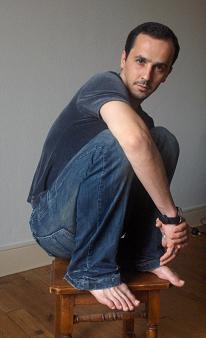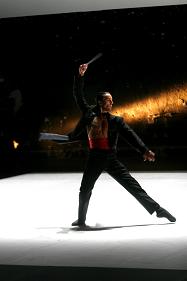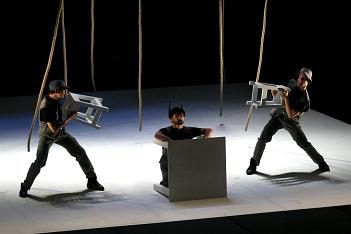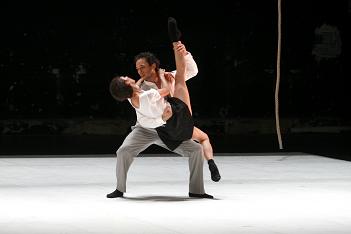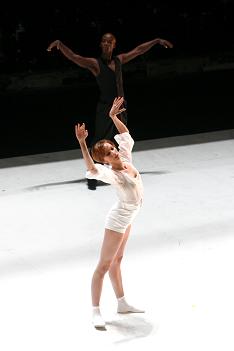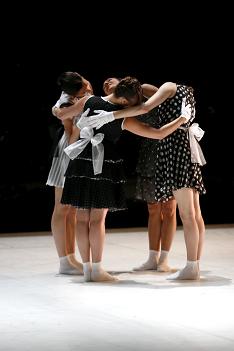It was an exceptional moment. One of those that introduce and make ballet beloved even to the most reluctant newcomers. This speaks to all the fabulous work done by the choreographer Gaël Domenger, humble under the warm ovations of the audience. An audience deeply touched by the emotional and sensual power, scenically infused into Felix Mendelssohn’s musical work “A Midsummer Night’s Dream”.
In the wake of Thierry Malandain, Director of the National Choreographic Center of Biarritz where he is in charge of training, Gaël Domenger, wisely engaged by the director of the Opera of Nice, Paul-Emile Fourny, for this production, is not an ordinary choreographer. A few minutes of conversation at the end of the performance are enough to grasp the richness of a man with a journey steeped – intertwined would be more accurate – with multiple cultural and artistic influences, which may appear contradictory to the layperson. But the former student at the Paris Opera Ballet School knows perfectly how to “articulate” them, akin to the bodies of dancers whose complex evolutions on stage he develops, orchestrates, and harmonizes.
First of all, Gaël Domenger managed, in the conception of his work, to integrate, even amplify, the romantic legacy left by the score— the overture and the stage music were written and performed 17 years apart— by composer Felix Mendelssohn, friend and contemporary of Robert Schumann, whose first symphony known as the “Spring” he conducted. According to him, this is a key reason to associate the two musicians in this production. Played for the first time in March 1841 in Leipzig—a city where Gaël Domenger has indeed presented many of his creations— Schumann’s “Spring Symphony” emerges one year after his marriage to Clara Wieck and the birth of his daughter: a joyful rebirth after the dark times experienced by the composer. This argument was also advanced by the young scenographer to evoke “the ancient May rites” suggested by William Shakespeare’s play. Furthermore, this music, which comes to “reinforce the resident composer,” serves as a means to “calm the discord between Oberon and Tytania,” the two protagonists of the original libretto, and allows “new pairs of young lovers to cross the gates of summer.” Thus, the first and second parts blend the two composers, interpreted with unity and passion by a Philharmonic Orchestra of Nice brilliantly conducted by Fabrizio Ventura.
Under the impetus of Gaël Domenger, the stage movements of the Ballet Corps of the Opera of Nice suggest unbroken, yet always fluid in expressivity, processes of articulation, embedding and disembedding of bodies. Neither entirely merged nor completely autonomous, they move and allow themselves to be grasped in order to maintain the body’s sensual, even erotic dimension. “Arms that become legs or vice-versa,” specifies Gaël Domenger.
These bodies also know how to lean, take theatrical support on objects to the point of making them alive and essential to their movements: Puck’s magic wand— the magnificent Cesar Rubio Sancho, faithful to the character’s histrionic tone—, Tytania’s mirror which is contested in a skillfully regulated gymnastic entanglement, solemn Oberon (Jamaal Le Var Phinazee) and Tytania’s knight (Joffray Gonzalez), a table, and stools around which Bottom, Flûte, and Snug playfully evolve— superb acrobatics by Hervé Ilari, Stéphane Ferrand, and Joffray Gonzales.
Several other scenes, dazzling in technique and yet moving in voluptuousness, illustrate these key elements: those of the two pairs of fugitives— admirable Laure Zanchi, Anaïs Bassot, Antonio Ceresia, and Pietro Latanzio— who meet then separate under the effect of the spell cast by Puck.
“The body is like a sentence inviting you to disarticulate it,” explains, in a posthumous work (“Petite Anatomie de l’inconscient physique ou petite anatomie de l’image,” Editions Allia, 2002) Hans Bellmer, an artist and major figure of Surrealism, whom Gaël Domenger seems to be largely inspired by in his scenographic conception. In 1934, Hans Bellmer decided to defy the rise of Nazism by creating an erotic doll, “an artificial creature with multiple anatomical potentials”.
An eroticism that the moving love scene between Tytania, enchanted by the “love thought,” a flower struck by Cupid’s arrow, and one of the craftsmen turned into a donkey, gives a duo of exceptional sensuality performed by Magali Journe, entirely consumed by the elegance of amorous grace, and Hervé Ilari, whose masculine build does not at all impair the suppleness, the sidestep, and the very natural acting.
For a choreographer, explains Gaël Domenger, “to dance is to know how to obey.” Like this curtain of ropes that, in the successive sequence of paintings, double, triple, intensify to create an increasingly constraining frame for the dancers without ever managing to imprison them. The fairy forest ultimately protects its secrets from the uninitiated eye. After the music, the bodies and the objects, the volume: the scenographer invents a geometric space, a square, represented from the beginning to the end of his work and perhaps intended to restructure, to delineate the stage dimension.
This measured figure provides the opportunity for a bold staging effect: at the time of Mendelssohn’s famous wedding march, a drape is folded from the four corners into which the four fairies are molded in a white dress— delightful Aldriana Vargas, Christine Nonelli, Julie Loria, and Stéphanie Barré— and its edges form a dance floor on which the couples Lysander/Hermia and Demetrius/Helena evolve, all in a meticulously orchestrated arrangement that denotes the artist’s extraordinary inventive capacity not to lose any of the scenic ensemble.
There is no need to congratulate Gaël Domenger for this production: not only did the audience widely do so, but the artist’s withdrawal behind the dancers and the conductor during the wave of applause speaks volumes about his modesty and intimate nature: the more the tree bears fruit, the more its branches bow to the ground!

